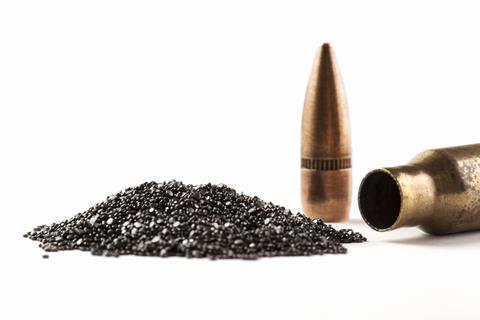Meera Senthilingam
This week, things get explosive, but with a twist. Michael Freemantle…
Michael Freemantle
Imagine sitting at your kitchen table with a wet apron drying in front of the cooker. All of a sudden, there is a loud whoosh. You turn round to see the apron consumed in flames. Well, that’s what happened to German chemist Christian Schönbein.

According to legend, Schönbein used to carry out chemistry experiments at home, much against the wishes of his wife Emilie. One day in 1846 – nobody is sure of the exact date – he heated a flask containing a mixture of concentrated nitric and sulfuric acids on the kitchen stove. Emilie was not home at the time. The flask broke spilling the acid over the floor. Emilie’s cotton apron was near at hand and so, the story goes, Schönbein grabbed it to wipe up the hot liquid. He then hung up the apron to dry.
He had unwittingly prepared nitrocellulose, a highly flammable material that later became known as guncotton. Cellulose is an organic polymer consisting of glucose units linked together in long chains. It is a constituent of cotton and other plants and the most abundant natural organic polymer on Earth. The explosive nature of guncotton stems from the high levels of nitrate in the material.
Many years earlier, Schönbein had taught maths and science at schools in England and France. He was a gregarious man and during this time made friends with eminent scientists such as the English chemist and physicist Michael Faraday. In Paris, he met the French writer Alexandre Dumas who achieved fame with his historical novels including The Count of Monte Cristo and The Three Musketeers.
Following his discovery of guncotton, Schönbein sent samples of what he called ‘his curious substance’ to Faraday and other scientists in England. He sent a letter to Dumas saying:
’You know, I think I have discovered a very simple method of transforming cotton into a material possessing all the necessary properties of a propellant.’
For much of the 19th century, European armies used gunpowder as a propellant for firing guns. Gunpowder is a mixture of charcoal, sulfur and potassium nitrate. It produces a lot of smoke when ignited. Schönbein pointed out to Dumas that his curious substance was not only much more powerful than gunpowder but also left no residue and produced no smoke.

Within a year of Schönbein’s discovery, gunpowder manufacturers John Hall & Sons began to produce guncotton using his process at a factory in Faversham, Kent. On 14 July 1847, however, a batch of the material exploded demolishing two buildings and killing 21 people.
English chemist and explosives expert Frederick Abel subsequently developed a safer method for manufacturing guncotton. In 1889, Abel and Scottish scientist James Dewar patented a smokeless propellant that consisted of guncotton and another high explosive, nitroglycerine, mixed together in a small amount of petroleum jelly. It was called cordite. The British Army and Royal Navy soon adopted it as their standard propellant.
The manufacture of cordite initially relied on the use of acetone as a solvent to mix everything together. But during the first world war, British supplies of the solvent became desperately short. Unfortunately, guncotton was insoluble in other common solvents. However, a less highly nitrated form of nitrocellulose, known as collodion, was found to be soluble in a mixture of diethyl ether and ethanol. Some munitions factories in Britain therefore used collodion instead of guncotton to make cordite. Throughout the war, the country manufactured vast quantities of cordite for the war effort using both forms of nitrocellulose. At the height of the war, for example, a factory at Gretna, a Scottish town on the border with England, was manufacturing some 800 tons of cordite every week.
Guncotton had many other uses in world war one. It was employed in torpedo warheads and some types of grenades. It was also used as a detonating explosive to fire guns and as a blasting explosive for blowing up bridges and the mines underneath enemy lines.
As for Schönbein, he died in 1868 when gunpowder was still the predominant explosive used throughout the world for both military and civilian purposes.
Meera Senthilingam
Science writer Michael Freemantle with some versatile weaponry, courtesy of guncotton. Next week, a compound hiding in the shadows.
Brian Cotton
When you have an infamous relative it can be easy to be overshadowed and overlooked – and there is always that danger for the organic compound toluene.
Meera Senthilingam
Find out why in next week’s Chemistry in its Element. Until then, thank you for listening, I’m Meera Senthilingam.
Michael Freemantle, is a science writer and author of The Chemists’ War: 1914 – 1918, published by the Royal Society of Chemistry in 2014













No comments yet